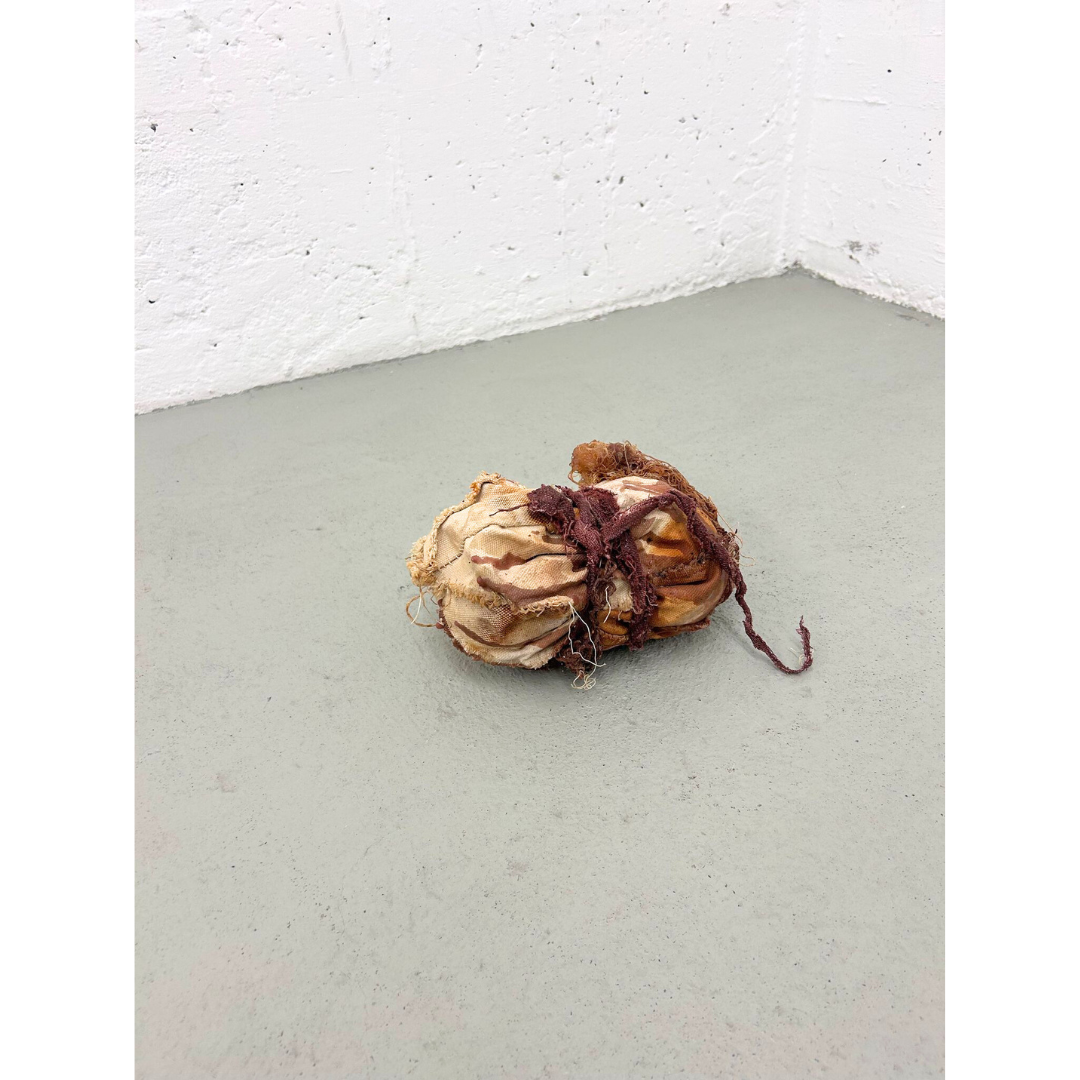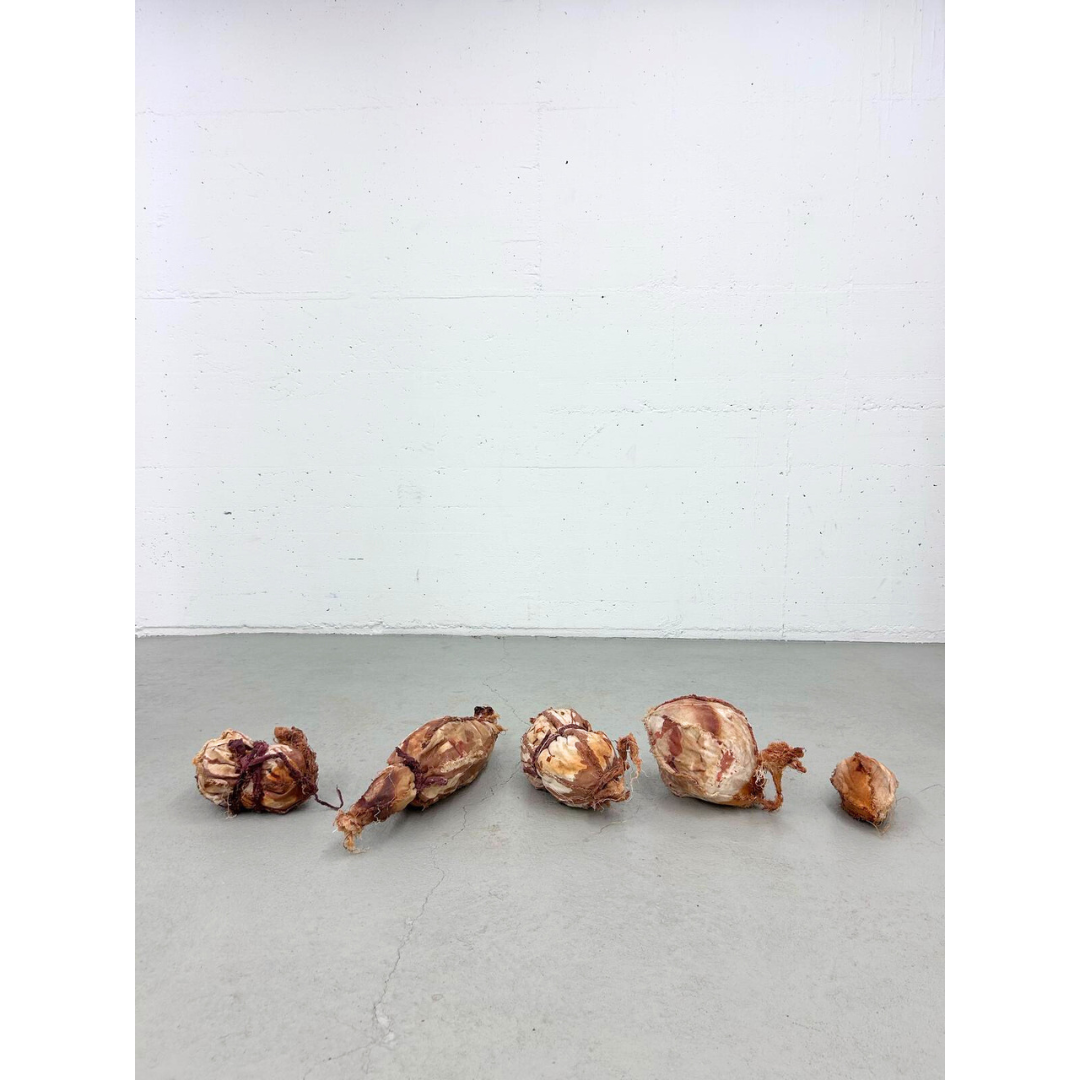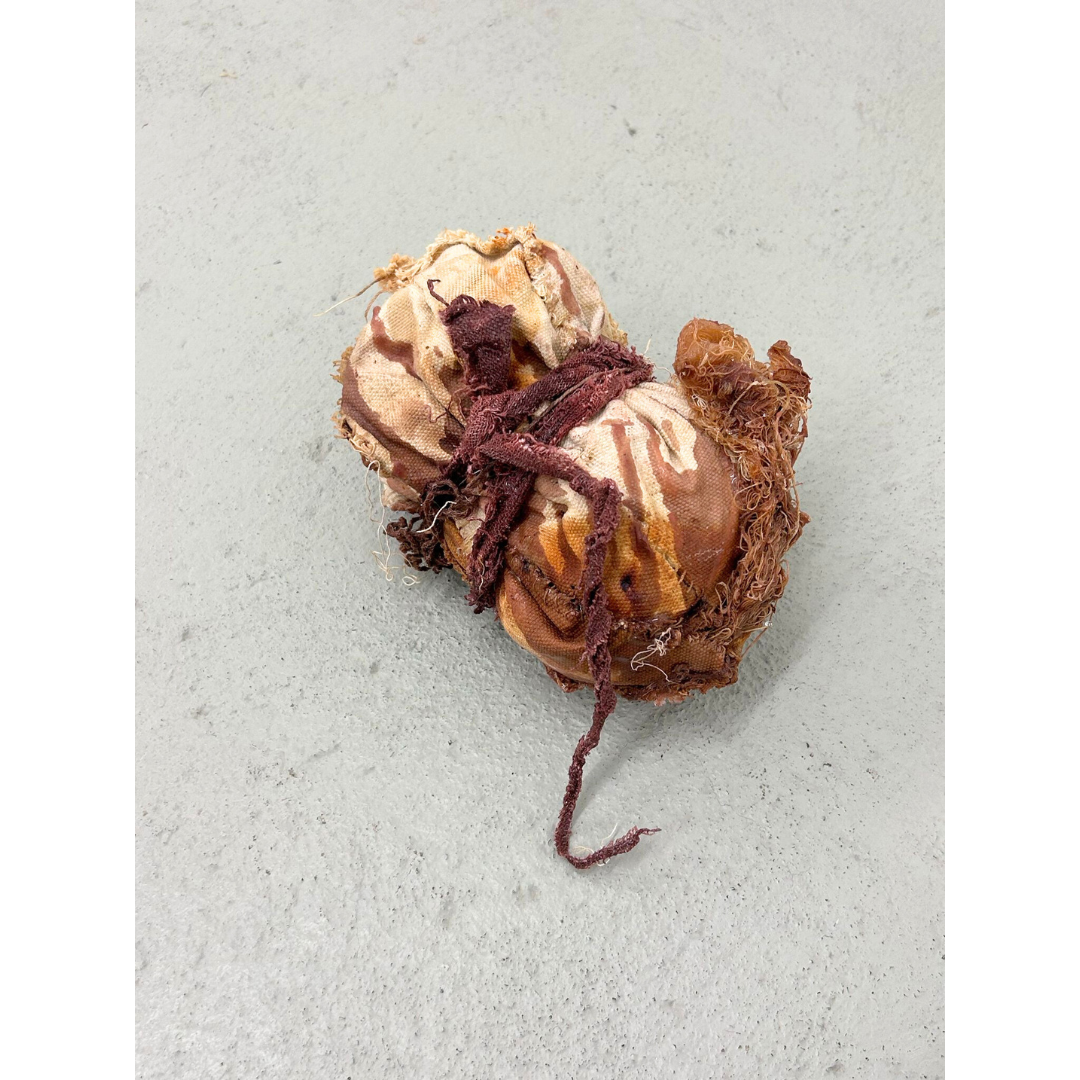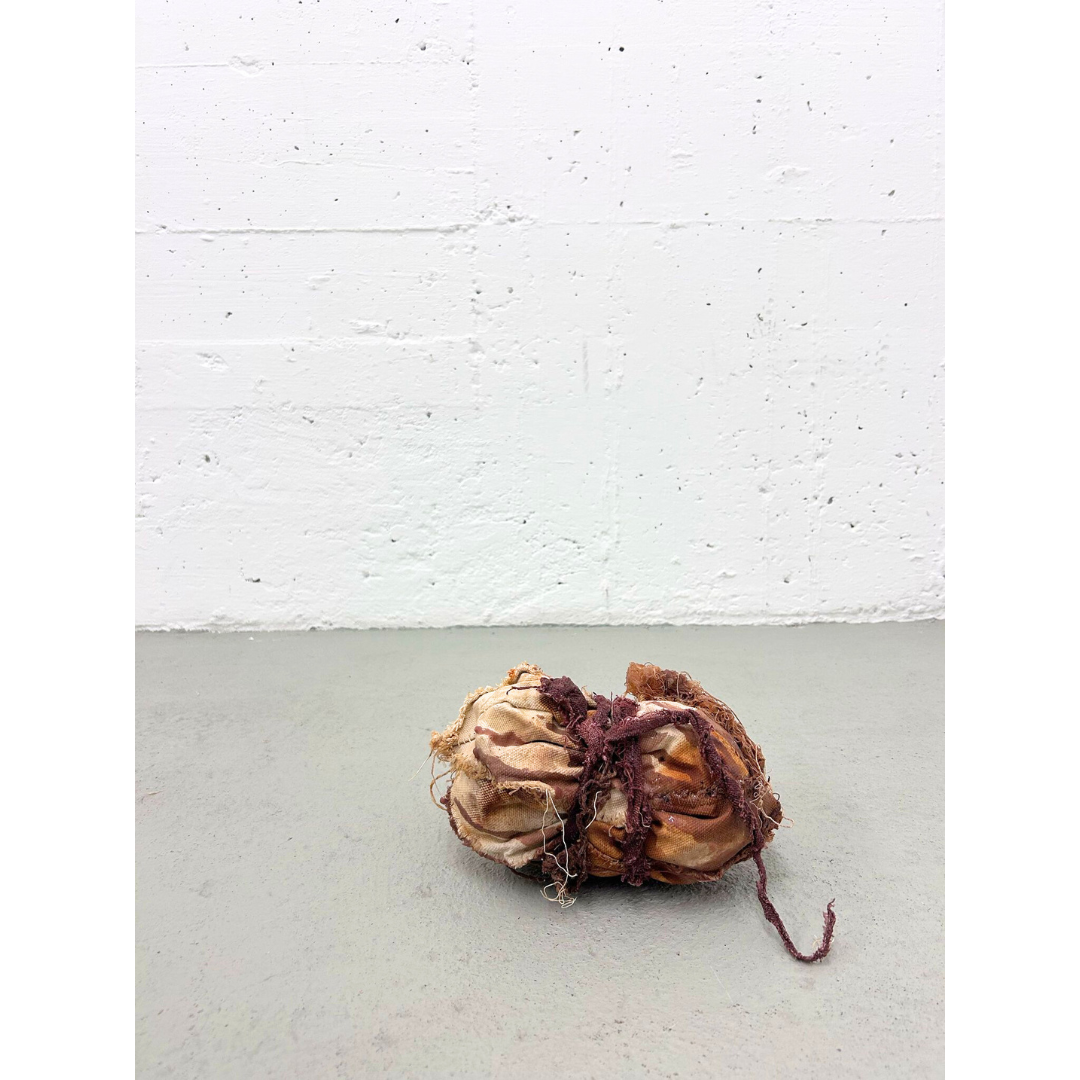







Close Considerations
Oxidation: Ophélie Napoli’s use of rust reflects both the chemical process of oxidation and broader cycles of transformation. It ties her work to the elemental degradation of matter through water, air, and time. Rust becomes a sculptural language of entropy and erosion, whether natural or human-induced. Her use of beeswax and iron oxide signifies the tension between the macro and microcosm.
Abjection: Through rust, torn canvas, and coagulated blood hues, Napoli embraces the abject and the bodily. Her work evokes the detritus, and the rejections of the human body… the pulse of the discarded. These surfaces reject polish and embrace rupture, mess, and failure. What emerges is a raw, visceral theme of residue.
Time: Rust, beeswax, and decayed fabric act as temporal agents embedded in the work’s skin. Napoli’s forms, like Eva Hesse’s “demoralised geometry” (Lippard, 1992, p.132),1 resist finality and remain in flux. The materials transform visibly over time, enacting cycles of disintegration and reformation. This process becomes both a method and a metaphor.
Material Opposition: Napoli is drawn to canvas for its “inelegant lack of sheen” (Pincus-Witten, 1987, p.19),2 resisting smoothness in favour of contradiction. Her palette moves from olive skin to blood red to ashen dried blood brown, invoking bodily states and waste. Each surface is a site of tension between beauty and abjection. The material world is embraced for its mess, friction, and failure.
1 Lippard, L. (1992). Eva Hesse. New York: Da Capo Press.
2 Pincus-Witten, R. (1987). Postminimalism. Thames and Hudson.




Process
Conceptual Evolution: Ophélie Napoli’s work begins through intuitive material exploration. Shapes evolved organically into marine-like forms, reflecting dynamic bodily structures. The transition from experimentation to thematic complexity, developing “variations on formal themes… absurd in their multiplicity” (Lippard, 1992, p.133),1 privileging accident, repetition, and intuitive evolution.
Material Preparation: Napoli created sculptural forms by stitching canvas, stuffing them with foam, and marinating them in rust solutions, accelerating their decay. This destructive reconstruction aligns with postminimalist interests in “the limp, the pliable, the cheap” against polished surfaces (Pincus-Witten, 1987, p.47).2 Each form expresses perpetual collapse and regeneration.
Wax and Epoxy Application: After rusting, the artist applied melted beeswax and epoxy resin, giving forms an oceanic appearance while solidifying movement into sculpture. This final stage created surfaces both fragile and preserved, mirroring Nietzsche’s suggestion that “in every desire for knowledge there is a drop of cruelty” (Nietzsche, 1967, pp.177-8).3 Napoli’s method, like Eva Hesse’s dipped resin pieces, captures fleeting gestures (Lippard, 1992, p.141).
Exhibition and Immersion: The installation engages viewers by positioning sculptures unpredictably, encouraging discovery and interaction. Some forms appear static and suffocating, others mobile and hidden, amplifying dynamic tensions. This curatorial approach mirrors her shift from “geometric… delicacy and assurance” to awkward unpredictability (Lippard, 1992, p.100). Movement and stillness coexist, altering spatial experience.
Numerological Significance: The decision to create five sculptures emphasises the numerological system for stability, also representing the artist’s own family. This deliberate structure describes the interconnectedness between small organisms within larger ecosystems. Napoli echoes Hesse’s attraction to “the absurdity of repetition” and ordered purposefulness (Lippard, 1992, p.201). The number five, like the grid, becomes a conceptual anchor amidst the choreographed chaos.
1 Lippard, L. (1992). Eva Hesse. New York: Da Capo Press.
2 Pincus-Witten, R. (1987). Postminimalism. Thames and Hudson.
3 Nietzsche, F. (1967). Beyond Good and Evil, trans. Helen Zimmern. George Allen and Unwin Ltd.




References
Absurdity and Time Masters: Ophélie Napoli draws inspiration from the French cartoon Time Masters, integrating creatures that observe human absurdity with humorous detachment. This renders her work like Eva Hesse’s “humorous, impressive, whimsical, pathetic” (Lippard, 1992, p.185).1 Both artists explore absurdity through exaggerated forms and repetition, demonstrating Adorno’s idea of a “meaningless game” (Adorno & Horkheimer, 1989, p.12).2
Bosch: Napoli references Hieronymus Bosch’s complex, surreal ecosystems, where creatures exist within independent narratives. This reflects her experience growing up in megalopolises like Hong Kong, emphasising individual roles within overwhelming systems. The miniature worlds evoke Bosch’s “ordered yet unavailable to comprehension” logic (Lippard, 1992, p.100), illustrating societal fragmentation “ruled by equivalence” (Adorno & Horkheimer, 1989, p.9), where everything is reduced to a common denominator.
Postminimalist Craft: Influenced by postminimalism and her training at Edinburgh College of Art, the artist’s practice foregrounds material instability, stitching, and craft. The hand-sewn structures challenge minimalist rigidity, expressing “temporality and a theatrical cult of manneristic personality” (Pincus-Witten, 1987, p.12).3 Her materials and techniques of layering, repetition, and decay emphasise displacement and bodily connotations without literal representation.
Sterling Ruby: Sterling Ruby’s expressive use of dripping, decaying materials resonates strongly with Napoli’s ecological and bodily themes. Her sculptures, like Ruby’s become “objects both alien and familiar” (Sirmans, 2016, p.40).4 This layering engages danger, echoing Hesse’s “poignant balance between pure aggressive physicality and dramatic inner self-expression” (Lippard, 1992, p.202).
Ecological Themes: The work articulates ecological destruction through detritus and marine life markers, echoing Maeterlinck’s ‘ant mill,’ emphasising society’s “directionless pursuit” (Wilson, 1975, p.398).5 Advancing from postminimalist principles, it embodies an “absurdist view of the world” (Pincus-Witten, 1987, p.51), emphasising our paradoxical relationship with nature and existential futility.
1 Lippard, L. (1992). Eva Hesse. New York: Da Capo Press.
2 Adorno, T. & Horkheimer, M. (1989). Dialectic of Enlightenment, trans. John Cumming. New York: Verso.
3 Pincus-Witten, R. (1987). Postminimalism. Thames and Hudson.
4 Sirmans, F. In STERLING RUBY, by Kate Fowle, Franklin Sirmans, and Jessica Morgan. Phaidon, 2016.
5 Wilson, E. O. (1975). Sociobiology: The New Synthesis. Harvard University Press.




